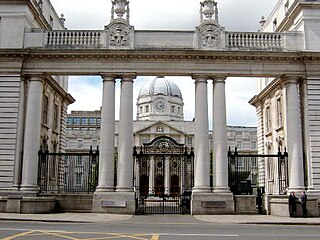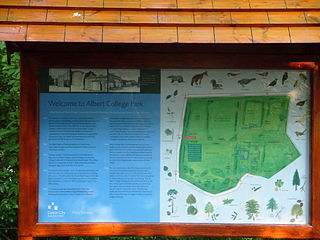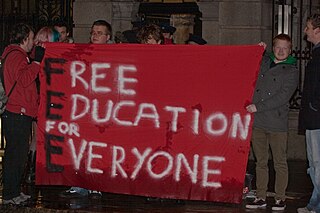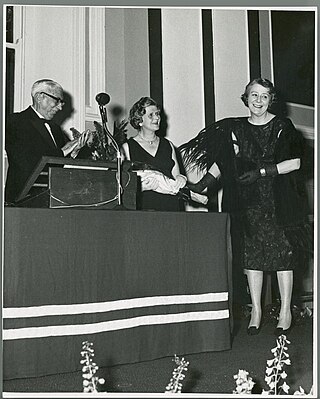
Dublin is the capital and largest city of Ireland. On a bay at the mouth of the River Liffey, it is in the province of Leinster, bordered on the south by the Dublin Mountains, a part of the Wicklow Mountains range. At the 2016 census it had a population of 1,173,179, while the preliminary results of the 2022 census recorded that County Dublin as a whole had a population of 1,450,701, and that the population of the Greater Dublin Area was over 2 million, or roughly 40% of the Republic of Ireland's total population.

The N11 road is a national primary road in Ireland, running for 129 km (80 mi) along the east side of Ireland from Dublin to Wexford. It passes close to Bray, Greystones, Wicklow, Arklow, Gorey, and Enniscorthy. Beyond Wexford, the route continues to Rosslare as the N25. The road forms part of European route E01. As of July 2019 the N11/M11 is of dual carriageway or motorway standard from Dublin as far as Oilgate in County Wexford.

The Royal Irish Academy, based in Dublin, is an academic body that promotes study in the sciences, humanities and social sciences. It is Ireland's premier learned society and one its leading cultural institutions. The Academy was established in 1785 and granted a royal charter in 1786. As of 2019 the RIA has around 600 members, regular members being Irish residents elected in recognition of their academic achievements, and Honorary Members similarly qualified but based abroad; a small number of members are elected in recognition of non-academic contributions to society.

Belfield is a small enclave, not quite a suburb, in Dún Laoghaire–Rathdown, Ireland. It is synonymous with the main campus of University College Dublin.

Government Buildings is a large Edwardian building enclosing a quadrangle on Merrion Street in Dublin, Ireland, in which several key offices of the Government of Ireland are located. Among the offices of State located in the building are:

Merrion Street is a major Georgian street on the southside of Dublin, Ireland, which runs along one side of Merrion Square. It is divided into Merrion Street Lower, Merrion Square West and Merrion Street Upper. It holds one entrance to the seat of the Irish Parliament, the Oireachtas, major government offices and two major cultural institutions.

Albert College was an agricultural college in the northern suburbs of Dublin, Ireland. Today its former main building, known as the Albert College Building, built 1851, is the oldest building on the Glasnevin campus of Dublin City University and contains the offices of the university president, other executive offices of the university, and those of the DCU Educational Trust. The Albert College Building also houses the 1838 Club, a restaurant for staff and postgraduate research students. The adjoining Albert College Extension, with laboratories for the school of engineering, was opened in 1985.

Rory O'Connor was an Irish republican revolutionary. He was Director of Engineering for the IRA in the Irish War of Independence. O'Connor opposed the Anglo-Irish Treaty of 1921 and was chairman of the Republican Military Council that became the Anti-Treaty IRA in March 1922. He was the main spokesman for the republican side in the lead-up to the outbreak of the Irish Civil War in June of that year. On 30 June, O'Connor was taken prisoner at the conclusion of the attack by Free State forces on the Four Courts in Dublin. On 8 December 1922, he was executed along with four other senior members of the IRA Four Courts garrison.

The National Concert Hall (NCH) is a national cultural institution, sometimes described as "the home of music in Ireland". It comprises the actual concert hall operation, which in various chambers hosts over 1,000 events each year, as well as Ireland's National Symphony Orchestra and three choirs: the National Symphony Chorus, Cor na nOg and Cor Linn.

The UCD School of Medicine at University College Dublin, Ireland, was founded in 1854. At undergraduate level, the school offers programmes in Medicine MB BCh BAO, BSc Biomedical Health and Life Sciences, and the BSc Radiography. At graduate level, the school UCD offers over 40 programmes for health care professionals.
Hugh Redmond Brady is an Irish academic, the 17th President of Imperial College London, and a professor of medicine. He was the 10th President and Vice-Chancellor of the University of Bristol. He is also President Emeritus of University College, Dublin (UCD), having served as UCD's eighth President from 2004 to 2013.

Free Education for Everyone (FEE) was an Irish student campaign group which was set up in September 2008 in University College Dublin (UCD) to fight the proposed re-introduction of university fees. FEE was active in Ireland's main universities, including University of Limerick (UL), University College Dublin (UCD), Trinity College Dublin (TCD), NUI Maynooth (NUIM), University College Cork (UCC) and NUI Galway (NUIG), and Queen's University Belfast.

The Ashbourne Cup is an Irish camogie tournament played each year to determine the national champion university or third level college. The Ashbourne Cup is the highest division in inter-collegiate camogie. The competition features many of the current stars of the game and is sometimes known as the 'Olympics of Camogie' because of the disproportionate number of All Star and All-Ireland elite level players who participate each year Since 1972 it has been administered by the Higher Education committee of the Camogie Association.
Belfield FM is University College Dublin's student radio station. The station began broadcasting in 1990. It was initially run as a part of the UCD Students' Union, under the remit of the entertainments office, before becoming an independent entity within the Students' Union (SU). Belfield FM disaffiliated with the SU at the end of the 2011/2012 college year, and is now run independently within the UCD Societies Council framework. The station forms part of UCD's "Student Media Network", along with The University Observer and The College Tribune. The station is run by volunteer staff and contributors, and broadcasts on week-days.

University College Dublin is a public research university in Dublin, Ireland, and a member institution of the National University of Ireland. With 33,284 students, it is Ireland's largest university, and amongst the most prestigious universities in the country. Five Nobel Laureates are among UCD's alumni and current and former staff. Additionally, four Irish Taoiseach and three Irish Presidents have graduated from UCD, along with one President of India.

Carmel Humphries MRIA B.Sc. M.Sc. PhD D.Sc. was an Irish zoologist, specialist in fresh water Chironomidae. She was the first female professor of zoology and head of department in Ireland, and devised a technique for the identification of chironomid flies that is still employed today.

James Joseph Drumm was an Irish chemist and the inventor of the Drumm battery.
Thomas Edwin Nevin was an Irish physicist and academic who had a distinguished career in the field of molecular spectroscopy. He was Professor of Experimental Physics and Dean of the Faculty of Science in University College Dublin from 1963 to 1979.

Roebuck, also originally known as "Rabuck", is a townland and the name of a former estate in the baronys of Dublin, Uppercross, and Rathdown in Ireland.















